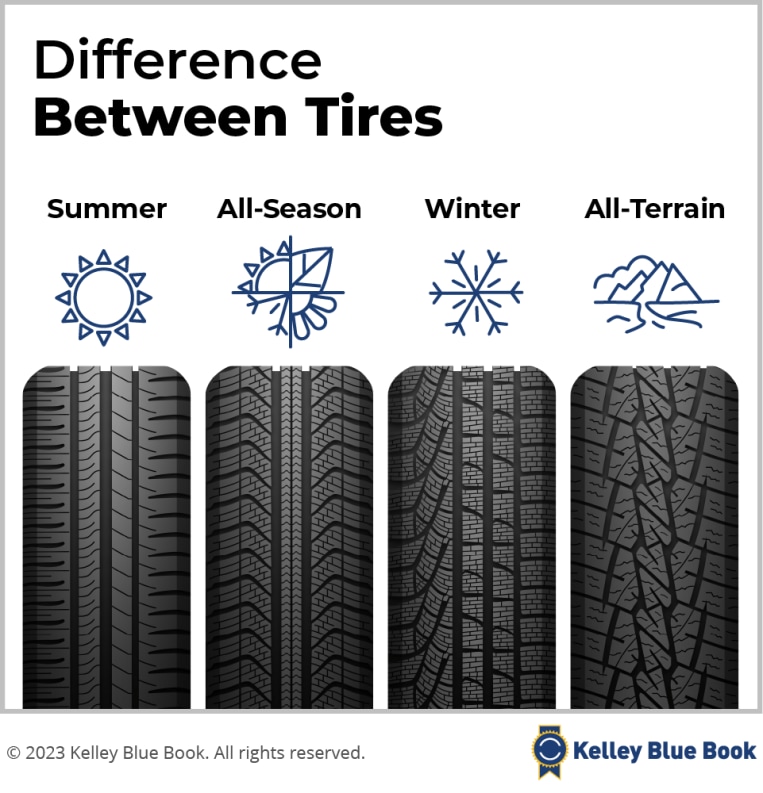- Winter tires go beyond traction in snow.
- Benefits include better braking.
- Tires for snow offer superior performance in cold weather.
- Snow tires last two seasons.
- They cost similar to standard rubber tires.
Many drivers have the misconception that a winter tire’s sole benefit over an all-season tire is better traction in the snow.
Think again. Experts with Canada’s Traffic Injury Research Foundation report that winter tires provide superior traction, braking, and cornering in all cold-weather driving conditions compared to an all-season tire. It’s about better tire traction whether the road surface is snow-covered, icy, wet, or dry. The foundation is an internationally recognized road safety research institute.
- Winter Tires Shorten Braking Distances
- Cold Weather Hardens Tire Compounds
- How Winter Tires Differ
- Benefits of Winter Tires
- How to Identify a Winter Tire
- Don’t Use Winter Tires in Summer
- How Much Should a Set of Winter Tires Cost?
- Are Winter Tires Worth It?
Winter Tires Shorten Braking Distances
The research revealed that braking distances were as much as 30% shorter for vehicles with winter tires than all-season tires. Winter tires also deliver better traction on ice- and snow-covered road surfaces at minus 22 degrees Fahrenheit (minus 30 degrees Celsius) versus an all-season tire at 39 degrees (4 degrees Celsius). The results appeared in the 2023 Canadian Consumer Winter Tire Study released by the Tire and Rubber Association of Canada.
When to Use Winter Tires
Many experts agree it’s best to switch to winter tires when the average temperature you’re driving in falls below 45 degrees Fahrenheit for a week. Take off winter tires when the temperature is routinely above 44 degrees.
RELATED: Car Tires Guide: Everything You Need to Know
Cold Weather Hardens Tire Compounds
When the average temperature drops to 44 degrees Fahrenheit or colder, tire compounds generally used for all-season and summer tires will start to harden. The tire will progressively lose traction as the temperature drops. Forty-four degrees is an industry-wide standard determined after years of winter testing.
Tire experts say that when temperatures drop, the rubber hardens, and the tread block becomes rigid. That’s when a vehicle tire starts to lose traction or grip on wet surfaces.
How Winter Tires Differ

The three main differences between all-season, summer, and winter tires are rubber compound, tread pattern, and structure.
The Tire and Rubber Association of Canada’s winter report said, “The superior grip of today’s high-tech winter tires is the result of more flexible rubber compounds that provide superior traction at extremely cold temperatures.
“These specialized rubber compounds coupled with sophisticated tread designs allow for greater control and braking capability on cold, dry, snow-covered, icy, or slushy roads. Shorter stopping distances in emergency situations represent the primary safety feature of the advanced technology in today’s winter tires,” the report said.
A winter tire’s tread pattern is different from the pattern on an all-season. For example, a winter tire has lots of sipes or small grooves cut into the tread blocks that allow the blocks to move but also stay rigid when the tire is rounding a corner. Those sipes allow for additional traction and braking. The tread pattern keeps the blocks free of snow by throwing the snow behind the vehicle as the tire rolls forward.
Also, manufacturers design some winter tires to perform better in snow and others to perform better on ice, the association said. They suggest you take your time to select the right tire for your region and vehicle.
RELATED: AWD vs. 4WD: Which is Better?
What Canadians Say
Canada knows something about cold weather. That country’s Traffic Industry Research Foundation said winter tires play a measurable role in increasing road safety and protecting drivers, passengers, and pedestrians.
The 2023 Winter Tire Report shows that 76% of Canadian motorists use winter tires. It also said that 81% of winter tire owners in Canada believe the winter tires on their vehicle saved them from losing control of their vehicle or colliding with another vehicle.
Benefits of Winter Tires
The report shows that putting snow tires on your vehicle can help you drive safer due to the following benefits in cold weather:
- Increased traction
- Enhanced Cornering
- Shortened braking distance
How to Identify a Winter Tire

When you see a “three-peak mountain snowflake symbol” on a tire’s sidewall, it’s identified as a winter tire. A tire carrying this symbol meets the industry’s snow, traction, and performance requirements on medium-packed snow. A word of caution: A few all-season tires carry the snowflake symbol. The three-peak mountain snowflake symbol is about pure traction, tire experts say. It does not evaluate for things like braking, turning, ice traction, and overall performance at lower temperatures. When you see M+S but not the three-peak mountain snowflake symbol, the tire is an all-season tire rated for mud and light winter conditions.
RELATED: Driving in Snow: Top Tips You Need
Don’t Use Winter Tires in the Summer
Winter and summer tires only have one thing in common: They are round. Each tire is composed of a specific compound made to handle extreme cold or extreme heat. They can’t do both. Engineers didn’t design winter tires for use in warm weather, so remove them when the snow season ends. High temperatures and hot pavement will quickly wear down the tread because of the soft properties of the tire compound.
Another reason to only use winter tires in appropriate conditions is reduced fuel economy. The soft rubber compound in winter tires creates more rolling resistance, which increases fuel consumption. So, wait until the average temperature is 45 degrees Fahrenheit or below for one week before putting them on, and take the winter tires off at the end of the season when the average temperatures go above 45.
Can I Use Winter Tires Year-Round?
Winter tires are designed for use in temperatures less than 45 degrees Fahrenheit. Replace them with all-season tires or summer tires for driving in warmer weather.
Proper storage in the offseason helps maximize their lifespan. Keep the clean tires wrapped in sealed plastic bags in a cool, dry place. Stand them upright, and do not store anything on top of them. Some tire shops provide fee-based storage to drivers who don’t have space to keep the extra set of tires at home.
How Long Do Winter Tires Last?
The useful life of tires depends mostly on your driving habits. Refer to the tire’s warranty for an idea of what to expect. You should rotate winter tires every 5,000 miles. You should replace winter tires when the tread reaches 6/32 of an inch. All-season tires should be replaced before the remaining tread reaches 2/32 of an inch. Start shopping for replacements before the remaining tread reaches the minimum depth.
Tire age is another factor in tire replacement. Even if plenty of tread depth remains, shop for new tires when they reach six years of age. It’s likely you can get two seasons out of a winter tire and at least two seasons out of a summer tire, if not more. So if you buy winter tires, you are probably not spending more. You are just splitting the use between winter and the rest of the year.
What’s the Proper Inflation for Winter Tires?
The proper tire pressure for a vehicle is listed on a sticker attached to the inside of the driver’s door, the inside of the glovebox door, or the owner’s manual. Keep in mind that each 10-degree Fahrenheit drop in outside temperature during the winter can mean a 1- to 2-pound loss in air pressure inside the tire. If the tire has a slow leak, the tire pressure could be underinflated by five to seven pounds or more. Proper tire pressure is critical to driver safety in every season.
When you don’t drive with the correct pressure in each tire, you present a different tire footprint on a road’s surface. You sacrifice the braking and steering performance the tires and vehicle were engineered to handle. As a result, it could bring instability and could mean longer braking distances for your vehicle. The same issues will result if the tires are overinflated. Check tire pressure at least once a month.
How Much Should a Set of Winter Tires Cost?
Expect to pay $1,000 and up for a set of four winter tires from a major manufacturer. Avoid unfamiliar brand names that might woo potential buyers with a low price. Experts say the tire’s snow, ice, slush, and dry performance will likely be far below that of recognizable brands.
Before buying winter tires, research prices and performance with tire service centers and dealerships.
Do I Need Winter Wheels for Winter Tires?
We recommend getting a separate set of wheels for your winter tires.
- Repeated mounting and dismounting strains the tire, and the stretching can potentially damage its structure and shorten its lifespan.
- Keeping winter tires on separate wheels makes it easier to swap them onto your vehicle when the seasons change.
Look for special offers when you’re looking for winter tires. Many shops have winter tire and wheel packages. While the extra set of rims is an additional upfront expense, it can easily pay for itself over time.
Are Winter Tires Worth It?
If you live in a region where wintery weather is plentiful and temperatures consistently drop below 45 degrees, then snow tires would be worth the investment. They help keep you safe, providing enhanced traction and cornering while shortening your braking distances.
READ MORE: Snow Tires Guide: Everything You Need to Know
Editor’s Note: This article has been updated since its initial publication.








